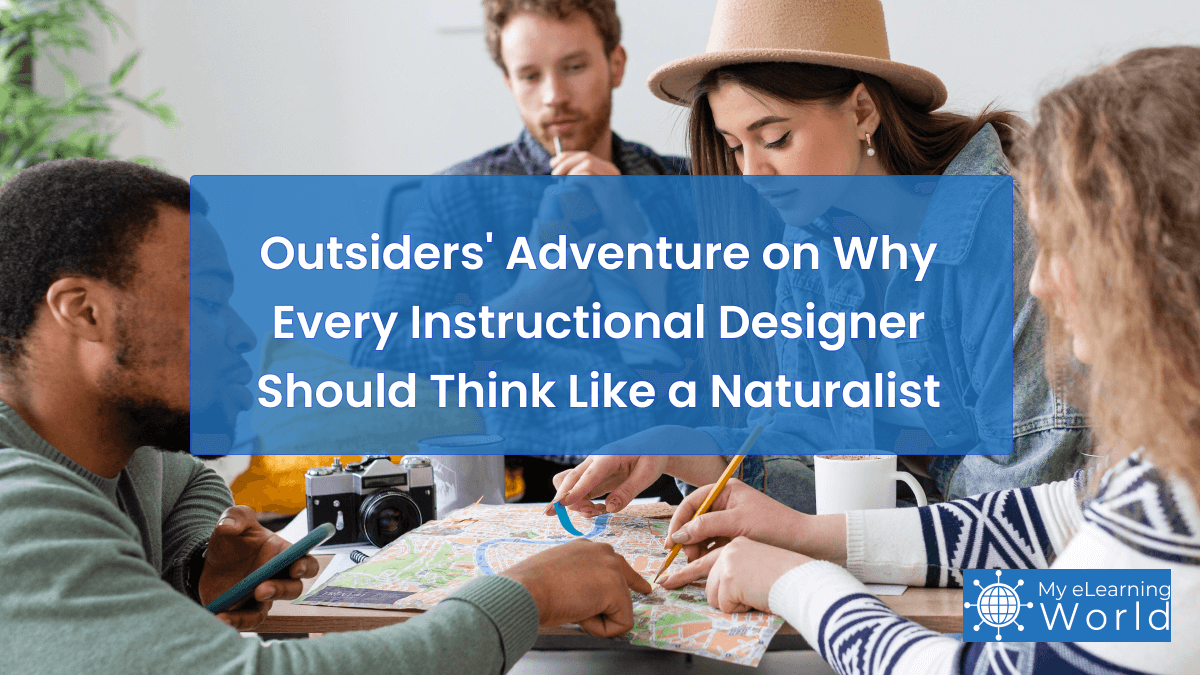There’s a quiet kind of brilliance found in those who spend time in the wild. Naturalists—whether they’re botanists, bird watchers, ecologists, or simply curious wanderers—move through the world with a sacred kind of attentiveness. They listen before they speak. They watch before they act. They adapt before they resist.
And I believe instructional designers and content creators could learn a lot from that way of thinking.
At Outsiders Adventure Co., our classroom doesn’t have four walls. Our students are often surrounded by trees, wind, and the hum of real life buzzing all around them. And just like naturalists in the field, we as educators must respond, shift, and sometimes pivot altogether based on what we observe. It’s that same attunement (the willingness to really “see”) that should be at the core of instructional design in any setting.
So here’s a radical idea: what if every instructional designer thought like a naturalist? What if content creators walked their digital terrain with the same presence, humility, and curiosity of someone tracking patterns in a forest?
What if the secret to better online learning isn’t always in the latest tech, but in returning to our roots?
Let’s explore what it means to be a naturalist—and how it just might make you a better designer.
1. Naturalists Observe First
A naturalist steps into the wild with a journal in hand, not a to-do list. They watch. They record. They take note of the small details most people miss—the color of the moss on the north side of the tree, the direction the birds fly when the wind shifts. They’re not looking to control the ecosystem—they’re seeking to understand it.
Instructional design should begin the same way.
Too often, we rush into designing courses with pre-formed assumptions. We’re quick to write outlines, build templates, and insert quizzes before we’ve fully understood the learners we’re serving. But when we start by observing—truly listening to our learners’ behaviors, needs, and barriers—we create something far more meaningful.
Practice naturalist-style observation in your design process:
Conduct learner interviews or surveys.
Watch how your content is engaged with—where learners pause, where they skip ahead.
Reflect on the emotional tone of your course. Are your learners curious? Overwhelmed? Disconnected?
The goal is not just to gather data, but to tune into patterns and adjust your approach with greater empathy.

2. Naturalists Are Adaptable
The forest doesn’t follow a script—and neither does a live class, a self-paced module, or a learning cohort made up of real, breathing humans. Naturalists don’t fight the seasons; they move with them. They understand that ecosystems change constantly and that rigid systems break under pressure.
A great instructional designer should be just as adaptable.
Whether it’s reworking a unit that fell flat, adjusting for a new learning style that emerges mid-course, or scrapping a whole lesson when it no longer serves the outcome—flexibility is not a flaw. It’s a feature.
Naturalists don’t call it failure when something unexpected shows up. They call it discovery.
Instructional designers can do the same.
Embrace adaptability by:
Building modular content that can be swapped or reorganized easily.
Including “pause and pivot” checkpoints during course development to reassess.
Offering multiple formats for the same content (audio, text, video) to meet diverse needs.
Think of yourself as a field researcher in your own learning environment. Take notes. Try new things. Don’t be afraid to leave the trail.
3. Naturalists Look for Interconnectedness
In nature, nothing stands alone. The bees need the flowers. The fox depends on the rabbit. Even the decay of a fallen tree feeds the soil for future growth.
Great instructional design recognizes this interconnectedness too.
Content doesn’t exist in a vacuum. A well-designed course acknowledges the learner’s whole context—their background knowledge, their future goals, their current emotional and cognitive load.
It also means thinking holistically. How does one lesson connect to the next? How does the design of your platform support (or hinder) their ability to engage? How does a learner’s identity and lived experience shape the way they interpret your content?
A naturalist sees the web of life. An instructional designer should see the web of learning.
Make your designs more interconnected:
- Scaffold content meaningfully, always connecting new learning to previous knowledge.
- Incorporate reflection prompts that link lessons to real-life application.
- Collaborate with subject matter experts, designers, and even learners themselves to keep a wider lens on the whole ecosystem.
4. Naturalists Appreciate Simplicity
A naturalist doesn’t need flashy filters or high-end gear to find wonder in the world. A single feather, the ripples on a pond, the rhythm of cicadas in summer—it’s enough.
Likewise, instructional design doesn’t have to be overly complex to be effective. In fact, simplicity often makes for the most powerful learning experiences.
Instead of overloading your course with jargon, animation, and excessive interaction, ask: What’s essential? What’s meaningful?
Naturalists know that it’s not about doing more, but seeing more clearly.
Create with simplicity in mind:
- Use clean, uncluttered layouts and accessible design.
- Prioritize depth over breadth—allow time for learners to reflect and engage meaningfully.
- Reduce cognitive overload with concise instructions and focused activities.
Let your learners experience the “aha” moment not from how much you gave them—but from how clearly you illuminated the path.

5. Naturalists Are Storytellers
Every stone, every trail, every bird call has a story. Naturalists don’t just recite facts—they weave them into wonder.
As an instructional designer, you’re not just a conveyor of content. You’re a guide. A narrator. A meaning-maker.
Use story to draw learners in. Frame each lesson with curiosity. Share real-world context. Let learners become characters in their own journey of understanding.
People don’t remember slides—they remember stories.
Bring storytelling into your design by:
- Using narrative structures in your lesson flow (challenge, struggle, discovery, resolution).
- Sharing case studies or learner testimonials.
- Allowing space for students to tell their own stories.
Design isn’t just about structure. It’s about soul. And that’s something naturalists understand deeply.
Final Thoughts: Be the Quiet Observer
Instructional design can feel fast-paced. Deadlines. Tech updates. Learning trends change by the month. But there’s a different kind of wisdom that comes when we slow down and listen like a naturalist.
There is an art to watching before acting, to creating from a place of insight instead of impulse. There’s strength in staying flexible, in respecting the ecosystem of learners and technology and time.
When you design like a naturalist, you build something sustainable. Something beautiful. Something that grows.
So here’s your invitation: grab your metaphorical field journal. Step outside the rigid paths of design theory just long enough to look around. Take notes. Ask better questions. Observe.
Because the most powerful content creators aren’t just experts—they’re explorers. And the wild has so much left to teach us.


